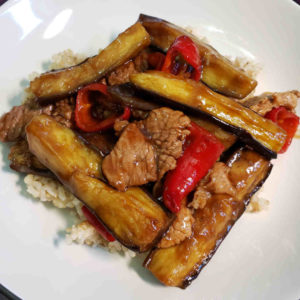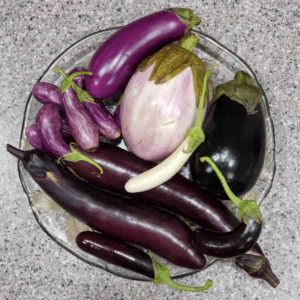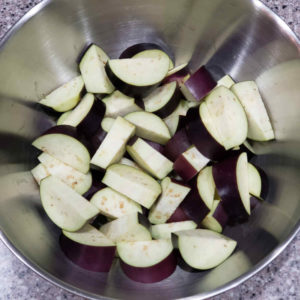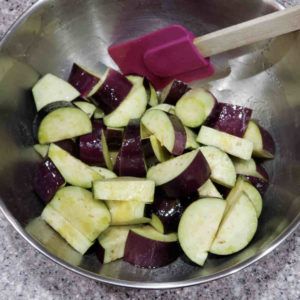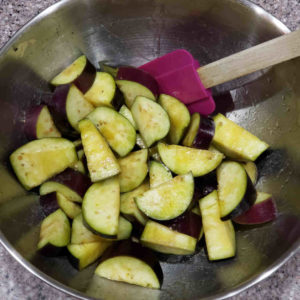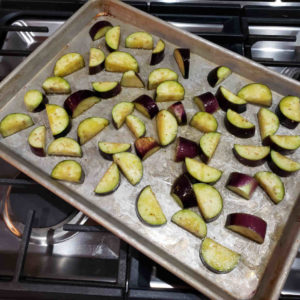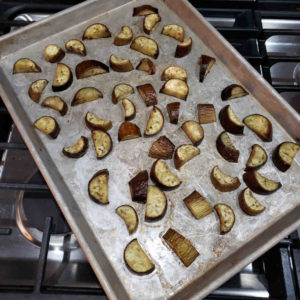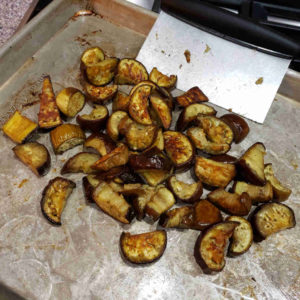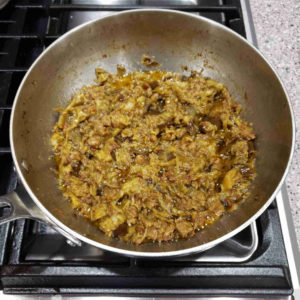Varieties
There are dozens of varieties of eggplant, as evidenced by the seed selections offered by Johnny’s Seeds and Southern Exposure Seed Exchange as just two of many seed sellers. But, to me, these many varieties can be split into four general classes of eggplant. First let’s mention the globe or American eggplant. This is what you see the most in American grocery stores. They are among the largest of eggplant varieties with dark purple skin and often with a bit of a pear shape. In the reference photo above, the eggplant at 3:00 is a small globe eggplant. Next are Italian varieties, which actually come in two styles. They are either slender in comparison to the globe eggplant, like the medium purple eggplant at the very top of the reference photo. They may also be egg shaped or almost spherical, such as the light lavender example just below the that first Italian eggplant. Then there are the Asian varieties, which are long and slender. The two larger eggplants at the bottom of the reference photo are examples of Asian eggplants. And lastly there are the “baby” eggplants. Fairy Tale eggplants, the little stripped guys at 10:00 in the reference photo, are a popular variety. But there are also a few other baby eggplants tossed into that photo.
Some people claim that some varieties are stronger flavored and others are milder in flavor. I honestly don’t notice that. Eggplant is mild in flavor and generally acts as a vessel to carry other flavors with it. What I do notice is that the mature seeds of eggplant can be a bit bitter. The skin can also be a bit bitter on the largest of eggplant. The easy solution is to stay away from oversized eggplants!
When selecting eggplant varieties, I think more the orientation of the flesh to the skin when the eggplant gets cut up, along with how I plan on using the eggplant. The eggplant’s flesh can become soft and fragile during cooking, while the skin acts as support. Take, for example, stir fry. I want there to be a sizable amount of skin on each piece of eggplant so it doesn’t get broken up when being pushed and tossed during the stir fry. So, either baby eggplants, cut in half, or Asian eggplants where I first cut them into quarters lengthwise before slicing them into segments. If I’m going to cut the eggplant into chunks and roast it, so it can be gently incorporated into a dish such as ratatouille or pasta alla Norma, then the fatter Italian varieties are my go-to.
Selecting and Storing

As I hinted at above, select the variety of eggplant based on how you will cook it. I’ll talk more about that in the cooking methods below. Also, hinted at above, don’t select eggplants that are too mature (that is, too large for their variety). But other than that, you are just looking for freshness. The skin should be smooth, not wrinkled or cut. The flesh should be firm, not mushy. They should also be heavy for their size. Sometimes eggplant have protuberances that look funny. As long as the skin on the protuberances is shiny and healthy, like over the rest of the eggplant, it’s just fine. I often pick these up at the farmers’ market because they make me smile. Like Mister Eggplant Head pictured here.
Once picked, eggplant has a relatively short shelf life. It’s one of the things I try to use up first after taking it home from the market. Storing it in the refrigerator will extend it’s shelf life, but keep it away from the coldest sections of your fridge. If eggplant is exposed to too cold of temperatures, the flesh can turn brown in patches. I’ve had this happen, and found the flesh still had it’s normal texture and it cooked up fine. But it’s much nicer to have the seeds be the only brown you find in an eggplant.
How to Cook Eggplant
Roasting
Of all the cooking options for eggplant, roasting is the one that I use most. When done this way, the surface of the eggplant flesh gets caramelized and firms up, holding together the flesh on the inside which develops a smooth, custardy texture. Toss roasted eggplant in a pesto and you have a nice side dish. Or you can incorporate it into dishes like ratatouille or pasta alla Norma. It also makes a great topping for pizza or for ramen.
There’s a little secret to the technique of roasting eggplant which I got from the Myers+Chang at Home cookbook. Myers+Chang is a popular, husband+wife owned Taiwanese restaurant in Boston. The book has a recipe for Hakka Eggplant where they roast the eggplant before they finish it by stir fry in the wok. The secret is to douse the eggplant in a solution of water, olive oil and salt. I’ve generalized the technique as follows:
Preheat the oven to 425°F. Clean and cut the eggplant into appropriately sized pieces and place in a bowl. In a small jar, combine 1 fluid ounce of water, 1 fluid ounce of olive oil and ½ teaspoon of salt for every pound of eggplant that you will be roasting. Close the jar and shake it vigorously. The salt will dissolve in the water forming a simple brine and the brine and oil will form an emulsion. The emulsion will be unstable. If you let the jar sit still for even 30 seconds, the water and oil will separate. Don’t give it that time. Immediately pour the emulsified brine and oil and toss the eggplant to evenly spread the emulsion over each piece. Now let the brine do it’s work for at least 15 minutes. You will see the appearance of the eggplant change as the brine and oil are absorbed into the eggplant flesh. Now spread evenly over a baking sheet, keeping space between each piece of eggplant. The time you want to roast depends on what you will do with the eggplant. If it will be seasoned up and served as a side dish on its own, you will want to cook it completely, which will take 30-40 minutes. If you will receive further cooking, say for a stir fry or pasta alla Norma, then you want some cook time to remain, so 20-30 minutes.
Grilling
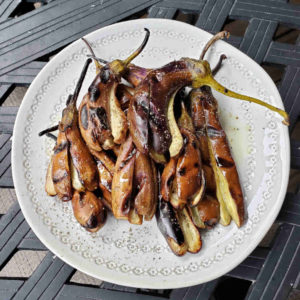
Like with roasting, a little pre-treatment of the eggplant before cooking helps to improve the final product. When I grill fairy tale or baby eggplant, I treat them the same way as I do roasted. First, I cut each eggplant with lengthwise slices, leaving the stem intact. Then I make the brine and oil emulsion with 1 ounce of water, 1 ounce of olive oil and ½ teaspoon of salt for every pound of eggplant. The small size of the baby eggplant allows them to toss nicely. Make sure that the oil-brine emulsion gets good contact with the cut sides of the flesh, and then let it do its work for 15 minutes. But, often on the grill, I like to have big slices of eggplant. Those are much more challenging to toss with a little bit of oil-brine emulsion. Instead, I slice them up in ½ to ¾ inch slabs, and then soak them in a brine of 1 tablespoon of salt in 4 cups of water. They like to float, so use a plate on top to weigh them down in the soaking bowl. After about 30 minutes I take them out and brush them with olive oil. Now they are ready for the grill.
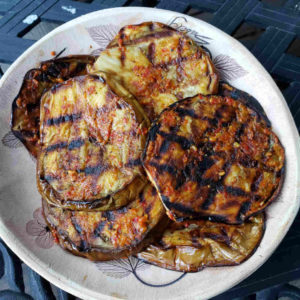
In either case, as I do with most vegetables, I start them on the hottest part of the grill so they get some nice color early on, and them move them to cooler spots to let them finish cooking under a more gentle heat. Just like with roasting, the goal is to have the inside of the eggplant flesh to have a nice, custardy texture. If you don’t give them enough time, they will chew like a dry sponge.
Melting
If you’ve ever had baba ghanoush, you know that eggplant can be cooked to a super soft and creamy texture. Cooked until it is “melted”, eggplant makes an incredible pasta sauce. It takes about 20 minutes on the stovetop to transform eggplant to this state. Starting the process with some savory ingredients, and cooking up a batch of pasta in parallel, you can get an inspired dish on the table in about 40 minutes.
I heard Francis Lamb mention melting eggplant on The Splendid Table. That led me to doing an internet search where I found his Melted Eggplant Pasta Sauce on salon.com. In that recipe, Francis flavors things up with some garlic, herbs, and sun-dried tomatoes. But eggplant cooked this way is so flexible, you can flavor it in so many ways. For example, one of my favorite flavor combinations for seasonal vegetables and pasta, Italian sausage, and Lemon, works great with melted eggplant. I have a recipe for that dish posted here. Or you can keep things vegetarian with sweet red peppers, herbs, and Parmesan. I have a recipe for that dish posted here. Or you can go more sweet and sour with briny pops of flavor in a pasta sauce that plays on the classic eggplant dish, caponata.
Like I describe above for roasting and grilling, I like to start by introducing chopped eggplant to an emulsification of 1 ounce each of olive oil and water and 1 teaspoon of salt per pound of eggplant. Give the eggplant a quick toss, and let it sit while you organize the rest of the recipe. Within 15 minutes, there will be visual changes in the texture on the cut edges of the eggplant. I usually start by sautéing onions with a bit of salt and a generous amount of olive oil, until they are soft and translucent. Then I add some garlic and sauté a little longer. Finally add the eggplant and about 1 cup of stock per pound of eggplant. Sauté the eggplant over medium high heat, stirring regularly. Use a wooden spatula to scrape up and incorporate any fond as it develops during cooking. Use the back of the wooden spatula to smoosh eggplant as it softens, or even pull out a potato masher for efficiency. Within 20 minutes, the eggplant should be melted and ready for finishing as a pasta sauce. In the accompanying photo, this is done with a splash of starchy pasta water and some grated Parmesan cheese.
Stir Fry
Coming soon!
